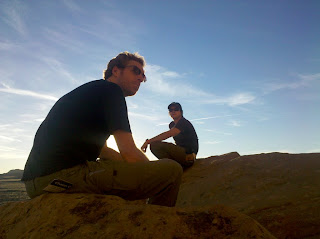I don't have pictures of either. Some things seem to sacred to even want to capture with a camera. Some things are too precious to view through an impossibly small lens.
The first was in West Africa, in a town 30 miles from the nearest electric generator.
The second was in Chaco Canyon on October 29, where Dan and I (and a couple of tag-alongs) spent our first joint field-exercise. None of us had ever been before, and it seemed like the perfect thing to do to take advantage of our field exercise to actually make ourselves get out of town, really out of town. The turn-off to Chaco is about a half way between Cuba and Farmington on 550, about 20 miles in on 8 miles of paved and then 13 miles of unpaved road, through what appears to be Navajo ranching country. Recent rains (how recent, who knows) had left pools of water in the carefully dug ditches on the side of the road, but the land looked so dry it might just crackle and combust.
We pulled into the camping parking lot (which you hit before the actual National Park, and just after the road turns back from dirt to pavement), where we encountered a sign that said, "Camping with the Ancients" (or was it "Sleeping with the Ancients"?). Either way, it struck me as funny, to think that ancients of one sort or another are relegated to this particular patch of earth, as if there weren't ancients at one time or another walking around the patches of earth that my house or our university currently occupies.
The fact that the road became paved near the Park, and that the campsites all have tent-pads, picnic tables, iron fire-rings with grills, housed in square slabs of cement, many of which appeared recently cleaned, was impressive. There was a notable lack of graffiti on everything. We pitched our tents in a cul-de-sac of sorts beneath towering sandstone cliffs that change colors gradually as the sun shifted and slid past them.
As others have been mentioning in their posts, this “natural” place is highly managed. The campsites, the well-maintained road, the ranger who came to check whether or not we had paid for our site, the official housing for the rangers and volunteers, the trails maintained with ropes and signs—both warning us to stay on the trail and pointing out particular features of the walking tour (fossilized clam shells, for example, with a “CLAMS” sign) and “PECKED BASINS” (where anthropologists conjecture that ceremonies were concluded with the deposition of corn pollen). There is much here that only a well-trained eye can see, and the signs, the guidebooks, the tours are all very helpful.
The most amazing thing to me, though, is what you can’t see, either because it’s a hundred miles away or still deep underground, unexcavated—there are several buildings and possibly other great houses that remain uncovered. As our guide explained, the best way to preserve the ancient architecture is to leave it buried, unavailable for prying eyes and hands.
The park is called the Chaco Culture National Park (not Chaco Canyon), and the intention in this (non)place name is to acknowledge the fact that the Canyon, while the center in some ways of a vast cultural system, is not the only place where these ruins are found. I think that Aztec Ruins, which Cathy visited, is probably also part of this extremely diffuse system that apparently drew people together from many hundreds of square miles. The first archaeologists to excavate seemed to think that a thousand or so people lived permanently at Chaco, based on the size and the complexity of the ruins they left behind. Now, though, they have rethought the mystery and come to different conclusions: perhaps only about 100-150 residents lived permanently in Chaco. After all, many of the inside rooms of the buildings would have been completely uninhabitable. It’s a great mystery why they built as much as they did, how long they had been in the area before they built, who exactly they became as they left the canyon and abandoned their settlements, how and when they began watching the sun and aligning their architecture with it, using many of their enormous buildings as giant sun calendars.
I was reminded, while there, of Barry Lopez and the stone horse. Reverence comes from the mystery. From knowing that I could never build this. That there is something here that is greater than we are, something here that confounds even our best science, our most modern methods of conjecturing about the past.
It seems to me that Chaco Culture National Park exists more than anything to preserve the mystery of the Chacoan legacy. The buildings have their historical, architectural, archaeological value, of course. (And I won’t pretend there isn’t economic incentive to charge visitors to come to the park… I’m sure that’s some of it.) But the place is a preservation of wonder, a reminder of the things we don’t know, can’t know, will never know, aren’t meant to know. Every story about Chaco is in some ways a story about ourselves, I guess.
And some pictures (with the ancients):










No comments:
Post a Comment